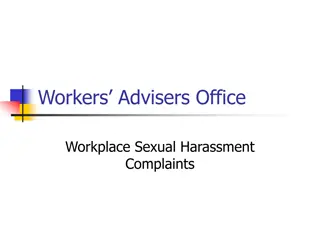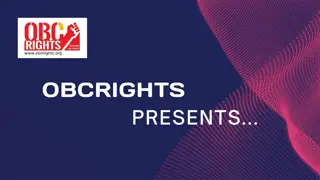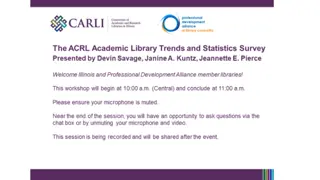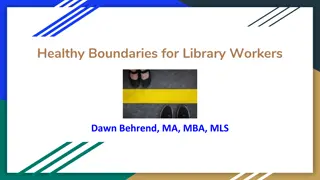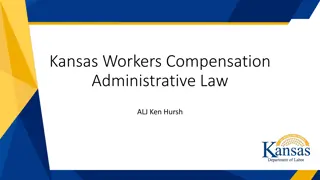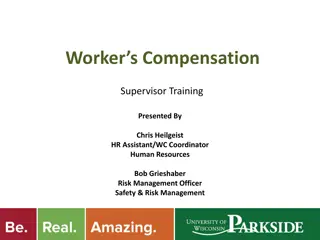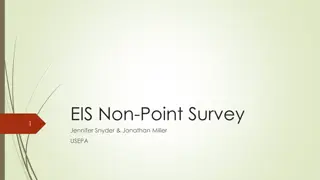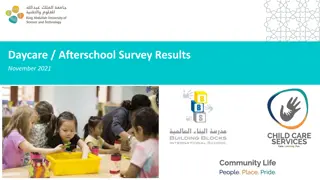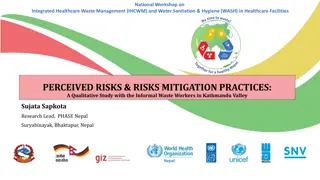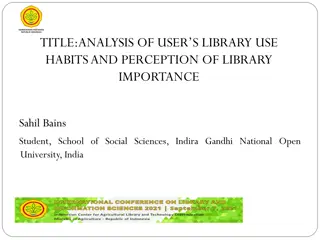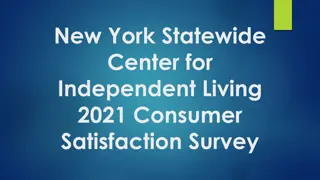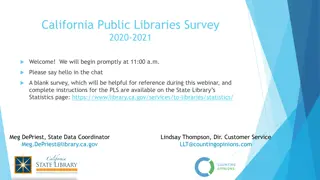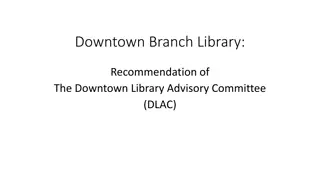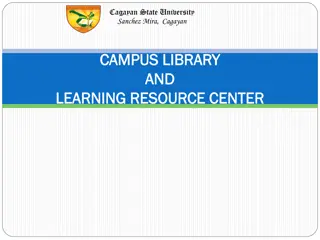
Understanding Employment Precarity Among Canadian Library Workers
Explore the findings of the National Survey of CUPE Library Workers on employment precarity, highlighting the challenges faced by library workers in maintaining economic stability and well-being. This study delves into the increasing prevalence of precarious employment and its impact on individuals, families, and communities, shedding light on the need for better support and policies in the library sector.
Uploaded on | 15 Views
Download Presentation

Please find below an Image/Link to download the presentation.
The content on the website is provided AS IS for your information and personal use only. It may not be sold, licensed, or shared on other websites without obtaining consent from the author. If you encounter any issues during the download, it is possible that the publisher has removed the file from their server.
You are allowed to download the files provided on this website for personal or commercial use, subject to the condition that they are used lawfully. All files are the property of their respective owners.
The content on the website is provided AS IS for your information and personal use only. It may not be sold, licensed, or shared on other websites without obtaining consent from the author.
E N D
Presentation Transcript
National Survey of CUPE Library Workers Employment Precarity Phase 2 June 2018 1 V i e w p o i n t s R e s e a r c h 2 0 4 . 9 8 8 . 9 2 5 3 w w w. v i e w p o i n t s . c a
*In 2013, a joint university-community research project was undertaken by McMaster University and United Way Toronto entitled Poverty and Employment Precarity in Southern Ontario (PEPSO). The study explored the characteristics of employment in the GTA-Hamilton labour market. The PEPSO study s summary report explains: Social scientists have adopted the term precarity to describe states of employment that do not have the security or benefits enjoyed in more traditional employment relationships. These precarious employment relationships are becoming the new normal for many in our workforce precarity has real implications for economic well-being and job security. But it also reaches out and touches family and social life. It can affect how people socialize, and how much they are able to give back to their communities. It can cause tensions at home. 1 The PEPSO study concluded precarious employment is increasing, and crosses all social and income categories. People in precarious employment earn less and face more uncertainty. Precarious employment has harmful effects on individuals, families and community life, and makes it more difficult to raise children. It both limits and enables community connections.2 ____________ 1 & 2It s More than Poverty: Employment Precarity and Household Well-being (Summary Report), Wayne Lewchuk et al., PEPSO Research Group, February 2013. 2
Background Phase 1 National random sample telephone survey Data Collection August and September 2017 Participants: Public Library Workers only 805 survey participants Margin of error: +/- 3.3%, 19 times out of 20 We can be 95% confident in the survey findings 3
Background Phase 2 National online survey Not a random sample survey Data Collection September to December 2017 Participants: Library Workers in Municipal, University, and School Board Libraries 805 survey participants Margin of error cannot be calculated for the online survey, because online respondents are self-selecting, not a random sample 4
Comparing Phases Variations between Phase 1 and Phase 2 responses are noted throughout the report. But any comparison of results between both datasets should be interpreted with caution due to differences in sampling methodology between the random sample telephone survey in phase 1 and the non-random sample online survey in phase 2. 5
Major Findings: 1. A large percentage of library workers are precariously employed. 2. Levels of precarity are similar between Phases 1 and 2. 3. Precarious employment is an equity or human rights issue. 6
R E S P O N D E N T P R O F I L E Municipal 29% n=222 Post- Other* 6% n=44 secondary 20% n=151 School board 44% n=335 *The other sector includes respondents who work in the provincial library system (4%), a regional library (2%) and who chose other (<1%). QUESTION Is the library where you work in a school or with a school board, part of a university, part of a municipality, a provincial library system, a public library board, part of a college, a regional library system or other? 7
N AT U R E O F E M P L O Y M E N T 45% N AT U R E O F E M P L O Y M E N T 17% Admin/accounting, branch head and IT (each 1%), maintenance driver and project/programming (each <1%) are not displayed on the chart. n=802 Phase 2 Phase 1 27% 17% 14% 13% 12% 11% 11% 4% 4% 9% 2% 2% Librarian Library clerk Library technician Library assistant Page Supervisor Other/more than one QUESTION What is your current position in your primary library job or contract where you worked the most hours and that paid you the most in the last 3 months? 8
R E S P O N D E N T P R O F I L E GENDER Other <1% Phase 1 Phase 2 Other <1% Male 13% Male 21% Female 85% Female 79% QUESTION Is your gender female, male or do you identify your gender in other terms? 9
R E S P O N D E N T P R O F I L E SEXUAL ORIENTATION Declined 5% Phase 1 Declined 3% Phase 2 Gay, lesbian, queer or bisexual 6% Gay, lesbian, queer or bisexual 7% No 89% No 90% QUESTION Do you identify as gay, lesbian, queer or bisexual? 10
R E S P O N D E N T P R O F I L E AGE 31% 27% 26% Phase 2 Phase 1 20% 19% 18% 16% 14% 11% 10% 6% <1% <21 21-30 31-40 41-50 51-60 61+ QUESTION Please indicate what age category you are in? 11
R E S P O N D E N T P R O F I L E INCOME 41% Phase 2 Phase 1 27% 26% 23% 14% 13% 13% 12% 9% 3% 3% 7% 5% 5% <$30K <$40K <$50K <$60K <$70K $70K+ Declined QUESTION In the last year what was your total employment income before taxes? 12
R E S P O N D E N T P R O F I L E EDUCATION Phase 2 Phase 1 36% 31% 28% 26% 21% 16% 15% 10% 2% 6% 7% 1% High school Colleg/tech/trade Some Post-sec Graduate post-sec Post Grad Declined QUESTION What is the last level of education you have completed to date? 13
R A C I A L I D E N T I T Y 67% White/Caucasian/European 70% 20% Canadian 11% Phase 2 Phase 1 2% South Asian/Indo-Canadian 4% NB The following each represent 1% or less of respondents and are not displayed on the chart: French, Filipino and other (each 1% in Phase 2), Black/African/ Caribbean, Latin American, West Asian, Korean and Arab (each <1%). 1% Chinese 6% 1% Indigenous 2% QUESTION What do you consider your racial background? 14
I N D I G E N O U S I D E N T I T Y Unsure 2% Unsure 3% Phase 2 Phase 1 Yes 1% Yes 1% No 96% No 97% QUESTION Are you a First Nations person, M tis or Inuk / Inuit? 15
R E S P O N D E N T P R O F I L E LANGUAGE French 21% French 1% Phase 1 Phase 2 Other 9% Other 4% English 89% English 74% QUESTION What language do you speak at home most of the time? 16
R E S P O N D E N T P R O F I L E CITIZENSHIP STATUS Phases 1 & 2 (identical results) Landed immigrant 1% Canadian citizen 98% QUESTION What is your current citizenship or residency status? Are you a Canadian citizen, a landed immigrant or do you have a temporary visa with work authorization? 17
R E S P O N D E N T P R O F I L E DISABILITY 11% 70% of respondents indicated they have no disability (77% in Phase 1) 11% 8% Phase 2 Phase 1 5% 5% 5% 4% 3% 3% 2% 2% 2% 1% 2% 2% 2% <1% 2% Physical disability Learning disability Health-related disability Mental health challenge Vision disability Hearing disability Temp/episodic disability Other disability Unsure QUESTION Do you consider yourself a person with any of the following: a physical disability, a learning disability, a health-related disability, a mental health challenge, Low vision/vision disability, hard of hearing, deaf or culturally deaf, temporary/episodic disability, some other disability not listed or are you a person without a disability? 18
N AT U R E O F E M P L O Y M E N T Unsure No Yes Phase 2 5% 28% 67% Phase 1 50% 48% 2% QUESTION Please tell me whether the following describes your current employment: I have one employer who I expect to be working for a year from now, who provides at least 30 hours a week, and who pays benefits. 19
N AT U R E O F E M P L O Y M E N T 63% Permanent FT (30+ hrs/wk) 39% 1% Permanent FT (hours vary, sometimes <30 hrs/wk) 1% 24% Permanent PT (<30 hrs/wk) 44% 4% Temporary PT (<30 hrs/wk) 4% 1% Phase 2 Fixed-term contract (I+ yrs) 1% Phase 1 3% Temp contract (<1 yr) 2% 3% QUESTION Please tell me which of the following best describes your primary library job or contract? Casual/on-call/day labour 9% 20
N AT U R E O F E M P L O Y M E N T 40% Started full-time 23% Phase 2 Phase 1 15% Less than a year 10% 28% 1 to 4 years 55% 26% Phase 1 n=328 Phase 2 n=513 12% 5 to 10 years 27% 5% 11 to 20 years 11% 1% QUESTION How many years did it take for you to secure a full-time position with this employer? >20 years 2% 21
S E E K I N G F U L L - T I M E Phase 1 Phase 2 PT looking for FT (n=466) Years looking PT looking for FT (n=277) Years looking 1-4 yrs 39% 1-4 yrs 40% 5-10 yrs 33% Yes 31% No 68% Yes 41% No 59% 5-10 yrs 16% <1 yr 34%* <1 yr 18%* 11+ yrs 6% 11+ yrs 10% *percentage of 142n *percentage of 114n QUESTIONS Are you looking for/applying for a full-time library job? IF YES How long have you been looking for a full-time library job? 22
H O U R S O F W O R K Decreased Stayed the same Increased 69% Phase 2 20% 7% 64% 27% 7% Phase 1 QUESTION Have your hours of work in this position either increased or decreased in the past five years, or have they stayed the same? 23
S E C O N D A R Y E M P L O Y M E N T Phase 1 Phase 2 Have more than one job? Also in a library? Have more than one job? Also in a library? No 58% No 83% Yes 18% No 82% No 81% Yes 19% Yes 17%* Yes 42%* *percentage of 147n *percentage of 150n QUESTIONS Do you have more than one job or contract? IF YES Is your secondary employment also in a library? 24
B E N E F I T S No Varies Yes 81% Phase 2 15% 3% 40% 56% Phase 1 2% QUESTION Do you receive any employment benefits from your current employer or employers such as a drug plan, vision, dental benefits or life insurance? 25
P E N S I O N No Varies Yes Phase 2 80% 10% 2% 68% 23% Phase 1 2% QUESTION Does your current employer or employers provide a private retirement income plan such as a pension plan or a contribution to an RRSP (Registered Retirement Savings Plan)? This does not include CPP - the Canada Pension Plan. 26
S I C K D AY S No Varies Yes Phase 2 80% 12% 8% 31% 64% Phase 1 2% QUESTIONDo you usually get paid if you miss a day s work because you are sick? 27
S C H E D U L I N G All of Most of Some of the time the time the time Never 11% 6% 78% Phase 2 3% Phase 1 9% 86% 2%/2% QUESTION In the last 3 months, how often did you work on an on-call basis, where you have no set schedule and your employer calls you in only when there is work? 28
S C H E D U L I N G Some of Most of Never the time the time Always Phase 2 83% 13% 1% 3% Phase 1 82% 3% 5% 10% QUESTION Do you know your work schedule at least one week in advance always, most of the time, some of the time or never? 29
U N I O N I N V O L V E M E N T No Yes Phase 2 40% 60% 51% 48% Phase 1 QUESTION In the past year, have you participated in any CUPE union events or activities, such as a meeting, conference, workshop, course or demonstration? 30
E M P L O Y M E N T P R E C A R I T Y Based on survey responses, members were divided into one of four employment precarity classifications: secure, stable, vulnerable and precarious. 31
E M P L O Y M E N T P R E C A R I T Y Precarious Vulnerable Stable Secure 22% 32% 36% 10% Phase 2 28% 24% 24% 25% Phase 1 Phase 1 n=770 & Phase 2 n=755 who answered all, or all but one, of the precarity questions 32
E M P L O Y M E N T P R E C A R I T Y School boards Post-secondary Municipal Other Overall 45% 20% 30% 7% 3% Secure 46% 33% 18% By Sector 3% 24% Stable 49% 25% Vulnerable 59% 10% 5% 26% 12% 57% 13% Precarious 18% 33
E M P L O Y M E N T P R E C A R I T Y Precarity is a Human Rights Issue! Precariously employed library workers tend to be: Women Gay, Lesbian, Queer, or Bisexual Have a Disability Be Indigenous or Racialized 34
E M P L O Y M E N T P R E C A R I T Y Results from Phases 1 & 2 Precarity tends to decrease as age increases Precarity tends to decrease as income increases Precarity is more prevalent in B.C. and the other Western provinces 35
E M P L O Y M E N T P R E C A R I T Y Precariously employed workers are more likely to: Work less than full-time hours Earn less than $40,000 annually Have more than one job Work as library clerks, assistants or pages continued 36
E M P L O Y M E N T P R E C A R I T Y Precariously employed workers are more likely to: Work in municipal libraries Be in locals of 500 to 999 members Not be active in their local unions 37
A C K N O W L E D G E M E N T S Viewpoints Research Shelly Gordon Joseph Leonard-Boland Brian Edgecombe Heather Farrow Genevieve Romard Suzanne Chamseddine Nicola From Kristine Dupuis Alice Audrain Monique Diotte


